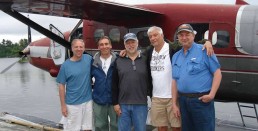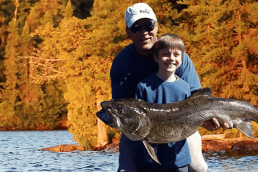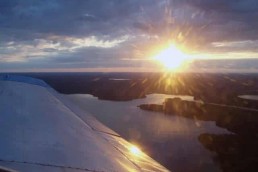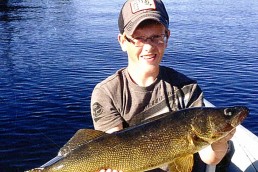Come Fly With Me
“What is your purpose in Ontario?”
“Fishing!”
The border official scanned the inside of the rental car—nothing but a spent coffee cup and a backpack. He thumbed through the worn passport, noticing the recent Belgium, France and New Guinea stamps.
“You are from Seattle?”
“Yes.”
“Where is your gear?”
“In the other car that I was supposed to meet. I didn’t think my flight was going to take off from Minneapolis to get me to Duluth in time to meet them so I rented a car in St. Paul and drove here.”
“Where are you fishing?”
“Some place north of here. We’re flying out on a floatplane tomorrow.”
“So, where are you staying tonight?”
“Some motel off to the left after I cross here.”
“The Super 8?”
“Yeah, that’s it.”
The official closed the passport and handed it back.
“Enjoy your stay in Ontario.”
So, was this a leap of faith on the part of the border official? Nah—border officials have seen stuff like this hundreds of times. The real leap of faith came from Dr. Rob Liddell in his trusting of four guys packing what he needed for his first Canadian fly-in fishing experience at an outpost cabin.
First, why would Rob want to trade the comfort of a commercial plane’s pressurized cabin for that of a de Havilland Otter that’s manufacture predates his own birth?
The reasons why this would be on his bucket list are numerous: the short version may be in giving in to one’s sense of adventure, experiencing a remote setting away from civilization and fishing a lake that gets little or no pressure. This type of trip can be exhilarating and fulfilling, but before pulling the trigger on this endeavor, there are factors to consider:
1. Cost of aircraft maintenance, aviation fuel and pilots.
These trips will typically cost more than drive-in camps. Budget accordingly, as all of the outfitters I’ve experienced have adhered to strict maintenance standards and have had stellar safety records.
2. American Plan vs. the Housekeeping Plan.
You might offset the cost of the fly-in by opting for the housekeeping plan. This creates another dilemma: How much food should you bring with you? How many meals of fish as opposed to other entrees will you eat? What about sides? You will have to stay within a weight limit. Get input from the outfitters that interest you. Listen and see if they have food packages where groceries could be prepositioned for you, and then ask them what is not included. They will have information about this on their websites too. We usually go with the outfitter’s food package and then supplement it with non-healthy and healthy snacks like trail mix. Circulate the outfitter’s food list and the supplemental food list to all participants so everyone has had a chance to critique it. You have to have the mindset that even the simplest items at a drive-in camp may not be on hand at your destination, like toilet paper and also seasonings for fish like salt and pepper.
3. Beer and gear use up your weight allowance.
Think about what you need as opposed to what you want to bring. Is it really worth the cost of an extra floatplane trip to bring in the extra cases of beer? Maybe, for some, but just be prepared to allow for it and its cost. I also like to apply what I call for some to be the “80-20 rule” when it comes to gear: you have to know if the 80 percent of it will never get used. So, I then strip out what I know I will never use and take only what is essential. And, those might include backups to the backups like the number of rods and reels you bring. With regard to rods, bring them in a rod case. As good as the outfitters are at packing—and as good as the pilots are—gear will shift and can damage an unprotected rod.
4. When you get to the destination, have the outfitter check the camp out with you.
Check to see if all appliances are operational, that the motors start and plugs for the boats can be found.
5. Know your geography, topography and be safety conscious.
Some fly-in lakes might be small enough that you might see your cabin from most of the spots from which you are fishing. Others might be large and dotted with islands. It doesn’t take much to get disorientated on these larger lakes. Have GPS and you need to know how to use it. Try to learn about the depths of the lake, as you will not have the benefit of marked shallow areas like you might find at a drive-in camp. Always wear your life jacket. And, if you’re really safety conscious, ask your prospective outfitter about renting a satellite phone.
6. If the fly-in destination abides by housekeeping rules, be prepared to work more.
You may have to earn your success at this trip more than you might be accustomed to at a drive-in camp. You might even have to help the outfitter set up the boats. You may be on your own with filleting fish and freezing your take home, if allowed to do so, at the location. I know some groups that hire a person to help out with tasks such as cooking, fish filleting, refueling boats, doing dishes, etc. Ask the prospective outfitter if these services are available.
7. Bring alternative forms of entertainment: books or a deck of cards.
Be prepared to stay busy if the weather does not cooperate. Allow yourself some wiggle room in your schedule to deal with potential delays.
8. Know how much fridge space you will have available.
Will you need to keep bait cold, or even beer or food? Aerated minnows only last so long, maybe four days in the best of conditions. With the right artificial baits though, you can be just as successful. We typically start making ice upon our arrival. We’ll start by boiling the water, as most cabins may not provide a potable water supply. Some outfitters may provide a couple of coolers of ice.
9. Know your cabin layout and accommodations now.
Is it dormitory style or private bedrooms? Do the rooms have doors or curtains? This might become important in mixed-gender trips. We also take ear protection to counter any high-decibel snoring. Also, warn all coming that the bathroom may be only an outhouse. Find out, and if this is a deal-killer, there are some outfitters who offer the full bathroom experience. Propane should be there to power your appliances and provide hot water, and there may be solar for token lighting. Some outposts might even have generators, but always make sure that there is an ample supply of charged batteries for must-have items like your depth finder and radio or boom box.
10. Finally, bring cameras and smartphones.
You will want to take pictures of all of the fish you catch—and you will catch them—and all else that Mother Nature provides.
A fly-in trip into the Canadian wilderness should be on every fisherman’s bucket list. Start preparing now in February. You can check out the fishing destinations advertised in MidWest Outdoors magazine that offer the fly-in experience.
MWO
SHARE THIS POST
Did you enjoy this post?
You can be among the first to get the latest info on where to go, what to use and how to use it!
Dave Schwartz
MidWest Outdoors works with more than 200 outdoor experts each year, who contribute articles based on their areas of expertise. MidWest Outdoors magazine offers more fishing and hunting articles than any other publication!



